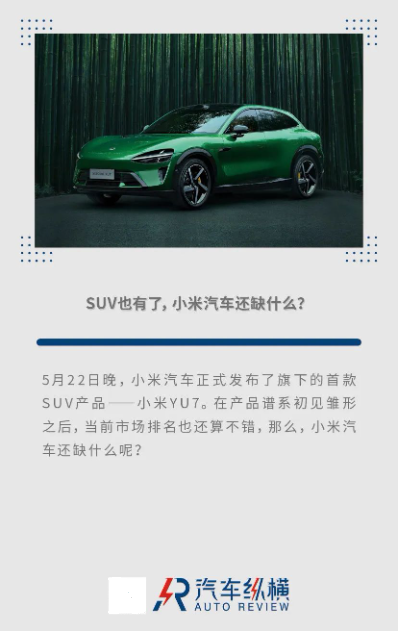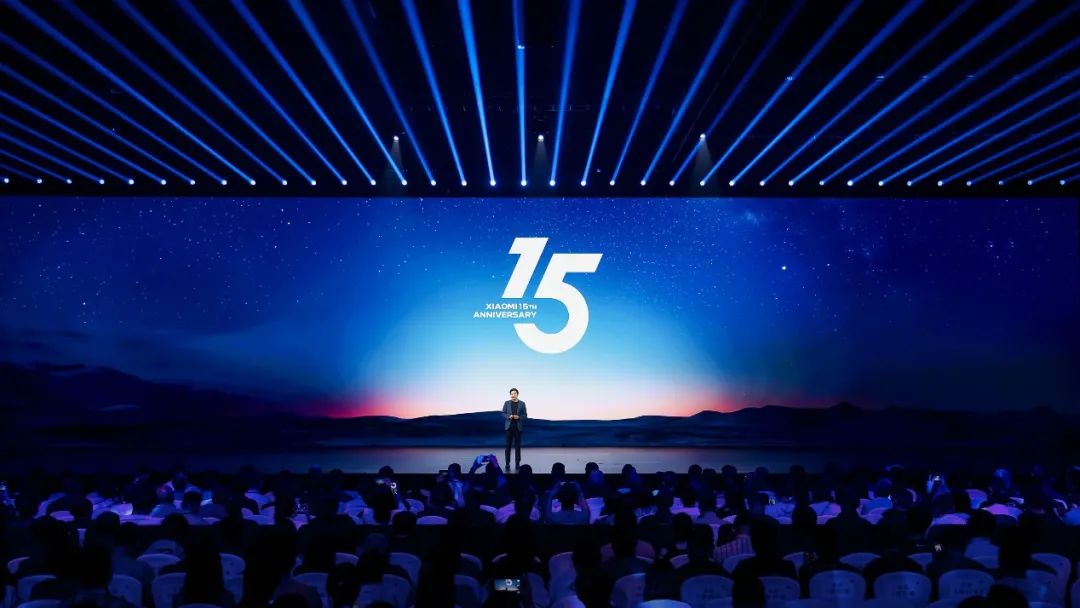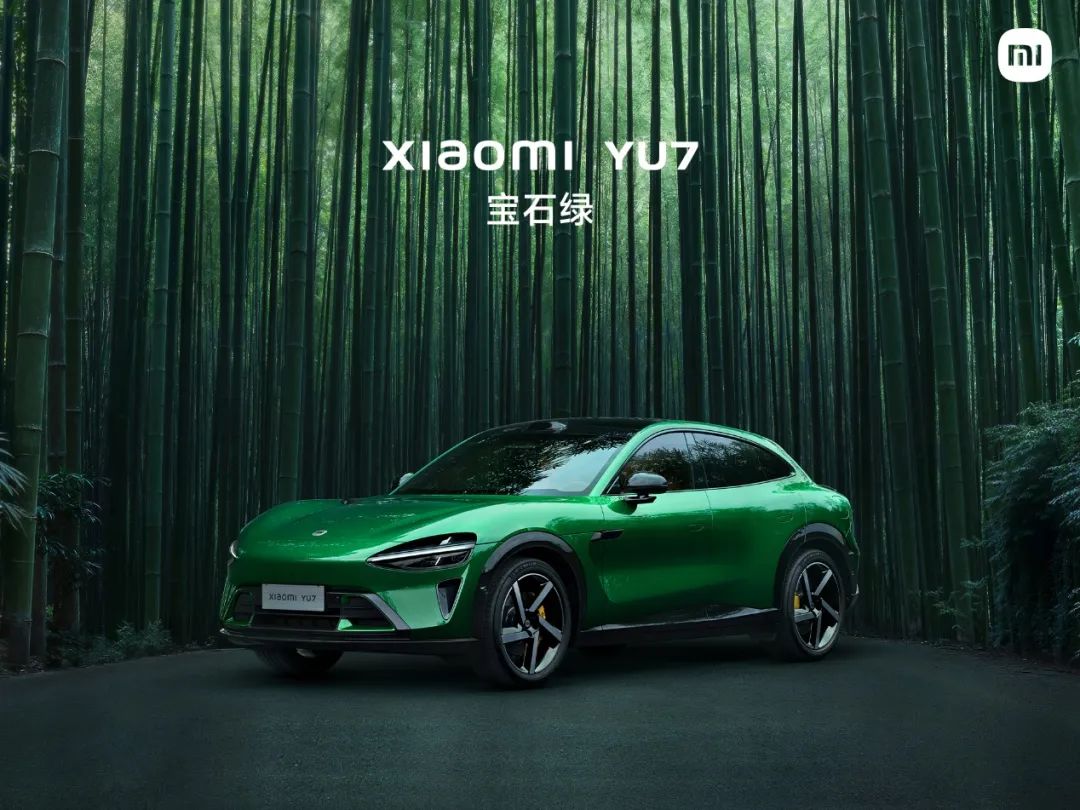What Does Xiaomi Still Lack Beyond SUVs?
![]() 05/26 2025
05/26 2025
![]() 526
526

"Questioning, understanding, becoming," seems to be an inevitable trajectory for Xiaomi Automobile. Despite the familiar narrative and style of the Xiaomi SU7 launch event, the evening of May 22 brought a distinct shift with the unveiling of Xiaomi YU7: Xiaomi Automobile's presentations are increasingly mirroring those of "traditional" automakers. From detailing exterior and interior designs to comparing performance parameters and functional configurations, the screen was awash with numerical data. Lei Jun, founder, chairman, and CEO of Xiaomi Group, delivered a speech that was less emotional and lyrical, more rational and objective, mirroring the automotive industry's gradual shift towards pragmatism.

Yet, post-launch, while deepening our understanding of the new vehicle, it inevitably poses a new question: With both sedans and SUVs in the market and performing well, what does Xiaomi Automobile still lack?
Cumulative Deliveries Exceed 258,000 Units
During the over two-hour event, Lei Jun expressed gratitude three times (the final "thank you all" at the close excluded). Firstly, he thanked everyone for their unwavering support of Xiaomi over the past 15 years. Secondly, he expressed special gratitude to Xiaomi's chip R&D team. Thirdly, he mentioned that Xiaomi Automobile's cumulative sales had surpassed 258,000 units, with SU7 deliveries in April exceeding 28,000 units, making it the sales champion in the price range above 200,000 yuan. Lei Jun said, "I sincerely thank everyone for their trust and support."
As we know, Xiaomi Automobile has recently experienced the "backlash" from increased attention. Strengths and weaknesses are both highlighted and amplified. While there are many positive praises, there are also negative comments. Lei Jun noted, "Xiaomi Automobile, chips, and smart factories have all completed the leap from '0 to 1.'" However, in the ultra-long race of the automotive industry, "from 0 to 1" is merely the beginning, and the long journey has only just commenced.
Lei Jun's remarks about chip startups during this event also apply to the automotive field: "On the path of exploring hardcore technology, Xiaomi is a latecomer and a chaser. We know it's difficult. We know that latecomers won't be perfect initially and will always face ridicule and doubt. These are all predictable." But he believes that the world won't always be dominated by the strong, and latecomers will always have opportunities.
Perhaps holding a new product launch event as scheduled is the best way for Xiaomi Automobile to demonstrate its courage and determination to face challenges head-on.
Tesla Faces a New "Threat"?
"At 15 years old, Xiaomi is no longer a newcomer in the industry. We no longer have a protection period for newcomers in any industry. We must set higher standards and goals." This is a statement Lei Jun made recently in an internal Xiaomi speech, evident in Xiaomi YU7.
When promoting mobile phones, Lei Jun's language was "close to the top level of the Apple industry" and "comparable to Apple." However, when comparing YU7 with Tesla's Model Y, his tone shifted to "having an overwhelming advantage." Perhaps in Lei Jun's view, Tesla has transitioned from being a target to catch up to being a competitor on the same stage today.
According to Lei Jun, Xiaomi YU7 is positioned as a "luxury high-performance SUV" with standard features across the lineup, including Xiaomi's Horizon Display panoramic screen, 700 TOPS of assisted driving computing power, LiDAR, and continuously variable damping shock absorbers. In Lei Jun's eyes, Xiaomi YU7 is not an ordinary, mediocre, boxy SUV. It is an SUV meticulously designed for drivers, combining elegant styling with high-performance sports capabilities while offering a sense of luxury and spacious comfort.

At the launch event, Lei Jun stated that from the perspectives of power, range, and luxury configurations, the Xiaomi YU7 Max version is advanced and has an overwhelming advantage over Tesla's Model Y. For instance, the Tesla Model Y Rear-Wheel Drive Standard Range Plus achieves 0-100 km/h acceleration in 5.9 seconds, while Xiaomi YU7 does it in 5.88 seconds. Additionally, Xiaomi YU7 uses a 96.3 kWh battery pack, offering a range of 835 kilometers in the standard version. In comparison, the Model Y's standard version only has a 62.5 kWh battery and a range of 590 kilometers.
In response, Morgan Stanley analysts led by Adam Jonas and Andy Meng wrote in a report previewing the YU7 launch that this new SUV will pose another challenge for Tesla. The analysts predict that YU7 will replicate the sales success of Xiaomi SU7, which received 120,000 pre-orders within 36 hours of its launch last year. They stated that Model Y's competitor boasts "stunning design."
The Road Ahead is Long and Arduous
With the launch of YU7, Xiaomi Automobile's current product lineup has essentially covered two major categories of important passenger vehicles. It can be said that the product spectrum is "taking shape." So, returning to the question initially posed, what does Xiaomi Automobile still lack?
Firstly, it is likely still production capacity. According to recent news, Xiaomi Automobile's Beijing Yizhuang factory has achieved double-shift production with a monthly capacity of 32,000 units, a 40% increase compared to the fourth quarter of 2024. Lei Jun also revealed during this year's Shanghai Auto Show that Xiaomi Automobile's second-phase factory will commence production in the third quarter of 2025, at which point total annual production capacity will exceed 500,000 units, ensuring subsequent vehicle deliveries. However, considering that Xiaomi YU7 will be released in July, if orders surge significantly, insufficient production capacity may remain a crucial factor constraining Xiaomi Automobile's sales growth before the second-phase factory commences production.
Secondly, there is public trust. Whether due to accidents or promotional issues, building brand loyalty and trust in the automotive industry takes time. As new products are launched, public attention towards Xiaomi Automobile will continue to rise, inevitably leading to more commentary. Old controversies haven't subsided, and new ones may already be on the horizon.
Thirdly, Xiaomi Automobile's path to internationalization has yet to commence. Previously, Lu Weibing, President of Xiaomi Group, revealed that Xiaomi Automobile is expected to officially launch its overseas layout in 2027. Until then, Xiaomi will focus on deepening its roots in the Chinese market and further consolidating its domestic position. However, for any automotive enterprise aiming to go further and steadier, internationalization is an inevitable peak that must be climbed. Once Xiaomi Automobile embarks on the path of overseas development, it will face new opportunities and challenges.
"The wind knows the strength of the grass, and a long journey reveals a horse's strength." This is a quote Lei Jun particularly likes. He candidly admitted, "Today's Xiaomi is definitely not strong enough and still has many unsatisfactory and imperfect aspects, but in the next five years, we will definitely deliver a better answer with more solid growth." The market is constantly changing, and technology is always innovating. Whether Xiaomi Automobile can ultimately achieve the goal of being among the "top five globally" that Lei Jun once proposed will be answered by time.
Images: Provided by the enterprise
Article: Auto Review
Typesetting: Auto Review








